In this second of three part series on the squat we will discuss foot placement, form and posture which aid in making a more efficient squat. In the first part of this series I discussed some of the important reasons as to why we should squat. Before I delve into specifics about aspects of squatting I want to remind the reader of some important details. First we all learned how to place ourselves in the squat position by starting on the ground first and allowed trial and error to “find” our own perfect squat form. No teacher stood next to us giving us cues or suggestions or tips—we simply kept trying and trying until we “got it” and we probably smiled when we achieved our first squat. My point is that it will truly take “you” to take yourself through trial and error and possibly endless repetition to slowly improve your squat. No one can do this for you but you.
Chances are you are past your teenage age years if you are reading this and years of sitting in classrooms, traveling in cars, making poor exercise choices and the litany of other daily environmental dysfunction has tarnished your once stellar squat. You are not alone. Very few young people today even in their college years possess an unblemished squat. Whole movement like a squat demand that multiple joints, muscles, fascia, motor control and lack of pain are working in total harmony. That ankle sprain you experienced in middle school, the torn ACL you injured on the ski slopes or that hip pain you developed while training for a marathon might already predispose you to a poor squat. The take away here is to acknowledge if you already are aware that you possess a movement problem. How well do you know yourself?

I’ve met people who know how fast it will take them to hike up Smelter Mountain within a few minutes but have no idea if they can squat well. Similarly, some people are oblivious to how well they can lunge or how well they can balance on one leg. Can you stand with your knees straight and touch your toes or touch the floor? Knowing how you move with just the force of gravity and the ground underneath you is the most basic movement information you should know about yourself. Why? Because from the second you left your mothers womb till about 12 months of age that is exactly the environment in which your brain learned how to move.

Yes you learned how to move. Most of the other primates and all other mammals popped out of mommy and within minutes to hours are up on their feet and walking around. Their nervous system was hardwired with the basic locomotion software to get them moving within day 1. You and I and every other human that ever walked this earth and every human that will ever walk this earth learned how to move through progressive patterns building on each other and culminating into efficient walking. Your brain is learning every second of the day you are awake. You are either learning something new every second or reinforcing something you already knew. You can always teach an old dog new tricks as long as the old dog wants to learn them.
Our brains’ awesome ability to continuously learn is a double-edged sword. It’s double-edged, because you can’t cherry pick what you want it to learn and what you don’t. What ever you are experiencing at the moment your brain is taking in the experience and learning something from it. When we were babies and learning to move we were full of mobility and a desire to move. We didn’t have sprained ankles, torn ACLs or unhappy hips, we were basically free from dysfunction and our brain learned how to move based on this clean slate. Once we developed handed-ness that was the beginning of dysfunction. The more asymmetrical you are in terms of what one side of your body can accomplish vs the other increases your risk of injury while you perform daily activities. Previous injury to a body part increases your risk of injury. Your brain has learned to overcome this issue.
At the top of the hierarchy about what your brain cares about is not how well you squat. It cares about survival! When you were younger and running around the yard and tripped on your knee you got up, assessed the situation and because your knee didn’t hurt “that” bad you kept running around. Except now instead of running around with flawless gait you are limping a little. Your brain doesn’t care, good or bad, you are experiencing a new way to move, right or wrong, optimal or not—you are still learning and you are learning how to run with a limp. The more you run with a limp the more your brain is learning a new pattern of running and if you continue to run in this new fashion your brain will totally re-write its software pattern. Until, you start running “normally” again and then your brain will re-learn the original pattern and your running pattern should return to its near original efficient pattern. Your brain cares about your survival. If you are still alive and you run with a limp, your brain is ok with that. Are You?

Why bring up how your brain learns? Because your squat pattern has probably been
slowly progressing into an inefficient pattern through the years or maybe you simply don’t squat at all. That is good news! You have realized your current baseline and since your brain has the ability to learn, you can learn a new and more efficient squat pattern. All you need is the desire and the right path. Let’s see if you are ready!
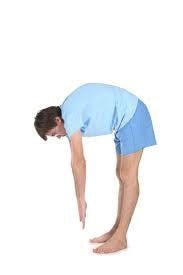
Stand up with your feet together and keep your knees straight. Now bend forward and touch your toes. Can’t reach your toes? YOU are not ready to SQUAT!
Why not?
Your hips are not bending enough. If you try practicing a full depth squat your back will be flexed forward to such a degree that it will be dangerous for your lower lumbar discs. There is a saying in physical therapy that proximal stability allows distal mobility. For every action there is an equal an opposite reaction. Therefore distal mobility allows proximal stability. If your hip joint which is distal to your core is stiff then reflexively your core cannot be stable. I have good news for you. You can still squat but off of a box. Off of a box you say. Does that sound strange. It shouldn’t because you do it everyday and have since you were in kindergarten. What kind of a box am I talking about — a chair!
So if you fall into this category of not being able to touch your toes in standing you need to work on the flexibility of your hips and work on box squatting. Box squatting is like squatting with training wheels on and I have clients squatting off low stools and benches all day long. For those of you that can touch your toes please read on.
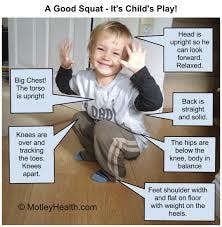
So you can bend forward in standing with your knees straight and touch your toes. Now you are ready to squat down to full depth. Place your bare feet about shoulder width apart or a little wider. Keep your feet facing straight ahead. Start lowering yourself down with a combination of bending your knees and flexing your hips. Try to keep your spine as vertical as you can. As you are lowering down try to actively push your knees outward using your hip muscles. Also as you lower yourself down keep your heels flat on the floor. If this a real struggle or impossible then we need to possibly re-assess matters. There are 3 big aspects of the squat we need to respect. Heels down. Feet facing straight ahead. Knees tracking over toes or tracking wider. Period.
Why do my heels have to be on the ground? When your heel bone, calcaneus, is on the ground then the posterior chain of your body becomes activated. The posterior chain is comprised of all the muscles on the back side of your body. If your heel comes off the ground the base of your support naturally becomes less and you are now performing a balancing act versus a stable squat. If your heel comes off the ground then your knee will pass over your toes considerably and the pressure in your knee can reach dangerous levels. This brings up the conversation of shoes with a raised heel, boots or “heels”. If you are wearing footwear with a raised heel and your job, workout or daily life requires you to squat repetitively expect to experience some anterior knee pain sooner or later. You were designed to walk, stand, squat, lunge, jog, sprint, jump, hike, dance and step all without a raised heel — so stop wearing them!


Why do my feet have to face forward? This makes it much easier for your knees to track over your toes or on the outside of your feet. The more your feet toe out the more you have to push your knees out even wider. So if your feet are facing forward when you squat and your knees buckle inward, push your knees out. If you can not because your hips are too weak then stop squatting. If you squat with your knees buckling inward you stand a good chance of injuring your meniscus, medial collateral ligament or your anterior cruciate ligament or a combination of the three. We talked earlier about your brain and the fact that its learning all the time. If you squat with your knees bucking inward and then perform that repetitively then you are learning how to squat poorly and this will create a hard habit to break. Also when you actively use your hips to push your knees out wide and your feet face forward you tend to elevate the arch in your foot— simply another bonus.
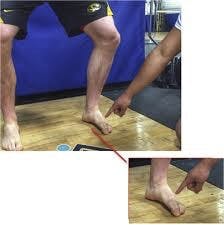
There is one caveat.
Do you have hip anteversion or retroversion? This is where the femoral neck is rotated forward or backward instead of normal alignment. If this is the case then your knee will naturally be rotated inward in the case of femoral anteversion. If your hip is retroverted then your knee will be facing outward. Similarly, your feet will face the same direction as your knee. You may have noticed throughout your life that you walked pigeon toed (feet facing towards each other) or walked more like a duck (feet facing outward). Now, it is wise to have a physical therapist check this status as you could simply have hip tightness which is giving a false positive that your hips are rotated. If that is the case you want to start walking and squatting with your feet and knees straight. If you have true hip anteversion or retroversion then a concession needs to be made about your feet placement. Get this checked out!

Are you afraid that pushing your knees out wider than your feet is just as bad as allowing them to collapse together? Fear not! There are no anatomical structures that are in peril when we push the knees out wider than the feet during a squat.
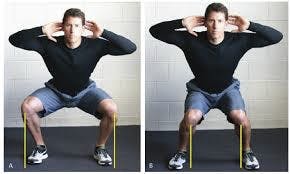
The last aspect of squatting we will discuss is keeping the spine in neutral and trying to keep the spine as vertical as possible. Keeping the spine in neutral is a much safer position for the spine and forces the hips into more flexion. The hips are designed for this flexion and maximizing hip flexion keeps the glute muscles working properly. When the spine is more vertical during a squat the pressure on the lower lumbar discs decreases. This is a win-win!
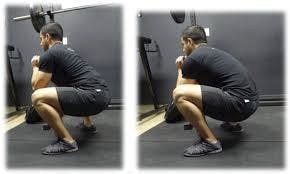
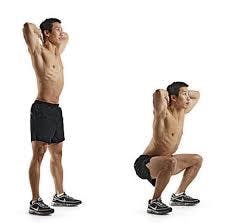
I will conclude this part two on the Squat with some more images and then a final thought. The third and final installment of this series will elaborate on how to incorporate the squat into your exercise program.

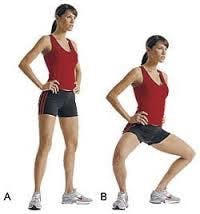

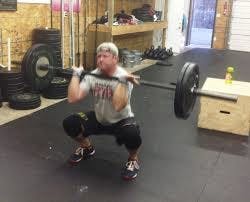

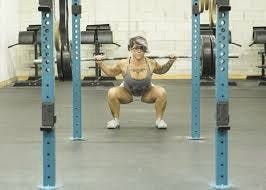
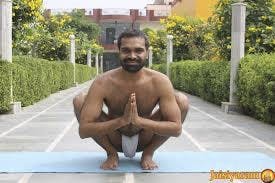
Why is it that non domesticated cultures squat so well? Maybe because they don’t know what a chair is. They probably don’t know what a TVA is, or a posterior glute medius nor an external oblique muscle. Why is that? Because they just simply squat as a sitting position. They don’t focus on reductionism nor muscle function. They simply squat be cause that’s what they have always done and if its not broke why fix it. They have not introduced chairs because, why bother, they already know how to sit. This begs the question- who is the more advanced society? The one who forces their society to sit in a non-functional way creating dysfunction? or the one who perpetuates challenging yet functional squatting in their culture? I’ll let you make up your own opinion.

